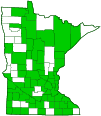Crown Rust
(Puccinia coronata)
Conservation • Description • Habitat • Ecology • Distribution • Taxonomy
|
|
||||||||||||||
Description |
Puccinia coronata is a fungal plant pathogen that requires two hosts to complete its life cycle. It has a broad primary (telial) host range, including more than 45 genera of grasses, and a narrow alternate (aecial) host range, mostly Rhamnus (buckthorns), but also Berchemia (supplejacks) and Elaeagnus (silverberries or oleasters). It is an economically important disease on cereals and grasses, including cultivated oats, barley, and rye. Recent molecular studies suggest Puccinia coronata is a complex of seven species and two varieties. Each species and variety can be distinguished only on the primary host, and each is identified by that host. Collectively they are referred to by the common name Crown Rust. On infected grass plants Crown Rust appears as light orange, pustule-like structures (uredinia) on the upper and lower leaf surfaces. It will occasionally also appear on leaf sheaths, culms (stems), the stalks of inflorescences (peduncles), and awns. The uredinia are the fruiting structures of the fungus. They are round to oval and up to On common buckthorn Crown Rust first appears as swollen, yellowish-green spots on the upper leaf surfaces, leaf stalks (petioles), and twigs. Leaves and twigs are disfigured but the infection is not fatal to the plant. |
Similar Species |
Habitat and Hosts |
More than 45 genera of grasses, including oat, barley, rye, quackgrass, slender wheatgrass, western wheatgrass, foxtail barley, and common buckthorn |
Ecology |
Season |
Early May to September |
Life Cycle |
The life cycle of Crown Rust includes five stages and requires two host species to complete. The five stages are teleoispore, basidiospore, pycniospore, aeciospore, and urediospore. First stage: Winter spores (teliospores), also called resting spores, overwinter on the remnants of infected wild grasses and on the residue of infected agricultural grasses left in the field. Second stage: In the early spring, the teliospores germinate and produce summer spores (basidiospores). The basidiospores are wind blown up to a half mile. Some are eventually deposited on the upper leaf surface of young leaves of the alternate host, common buckthorn. Third stage: In early May, bright yellow spots appear on the upper leaf surface. Each spot contains flask-shaped reproductive structures (pycnia) below and breaking through the upper leaf surface (epidermis) of the leaf. The pycnium is an aerial vegetative body made up of cluster of branching, receptive filaments (hyphae). The pycnium releases spores (pycniospores) in a thick, sweet liquid which attracts insects. The pycniospores are carried by insects or splashed by rain to the receptive hyphae of another nearby pycnium. Fourth stage: The fertilized pycnia produces a raised, orangish-yellow “cluster-cup” (aecium) on the lower leaf surface. The aecium releases aeciospores which are carried on air currents. Fifth stage: Aeciospores that land on an alternate host develop into a another kind of spore-producing body (uredium). Within 7 to 10 days asexual spores (urediospores) are formed and released. The urediospores are carried by gravity or wind to other plants and other parts of the same host plant. Generation after generation of urediospores are produced throughout the growing season, continually reinfecting the plant or crop. At the end of the growing season teliospores are produced and the cycle begins again. |
Distribution |
||
|
Sources Biodiversity occurrence data published by: Minnesota Biodiversity Atlas (accessed through the Minnesota Biodiversity Atlas Portal, bellatlas.umn.edu, 6/13/2025). |
|
| 6/13/2025 | ||
Occurrence |
||
Widespread and very common |
||
Taxonomy |
|
Kingdom |
Fungi (Fungi) |
Subkingdom |
Dikarya |
Phylum |
Basidiomycota (club fungi) |
Subphylum |
Pucciniomycotina |
Class |
Pucciniomycetes |
Order |
Pucciniales (rust fungi) |
Suborder |
Uredinineae |
Family |
Pucciniaceae |
Genus |
Puccinia (orange-yellow rusts) |
Subordinate Taxa |
|
Puccinia coronata s.str Puccinia coronata var. avenae (Oat Crown Rust) Puccinia coronata var. avenae f. sp. avenae Puccinia coronata var. avenae f. sp. graminicola Puccinia coronata var. coronata Puccinia coronati-agrostidis Puccinia coronati-brevispora Puccinia coronati-calamagrostidis. Puccinia coronati-hordei Puccinia coronati-japonica Puccinia coronati-longispora |
|
Synonyms |
|
Aecidium catharticum Aecidium crassatum Aecidium crassum Aecidium frangulae Aecidium irregulare Aecidium rhamnatum Aecidium rhamni Caeoma crassatum Caeoma crassum Caeoma rhamnatum Dicaeoma gibberosum Dicaeoma rhamni Puccinia alpinae-coronata Puccinia calamagrostidis Puccinia calamagrostis Puccinia coronata Puccinia coronata f. agrostidis Puccinia coronata f. agrostis Puccinia coronata f. alopecuri Puccinia coronata f. festucae Puccinia coronata f. holci Puccinia coronata var. alopecuri Puccinia coronata var. arrhenatheri Puccinia coronata var. avenae Puccinia coronata var. bromi Puccinia coronata var. elaeagni Puccinia coronata var. epigejos Puccinia coronata var. festucae Puccinia coronata var. gibberosa Puccinia coronata var. golestanica Puccinia coronata var. himalensis Puccinia coronata var. holci Puccinia coronata var. hordei Puccinia coronata var. intermedia Puccinia coronata var. lolii Puccinia coronata var. rangiferina Puccinia coronata var. secalis Puccinia coronata var. sertata Puccinia coronati-hordei Puccinia epigejos Puccinia gibberosa Puccinia lolii Puccinia rangiferina Puccinia rhamni Solenodonta coronata Solenodonta epigejos Solenodonta gibberosa Solenodonta rangiferina |
|
|
|
Common Names |
|
Crown Rust |
|
Glossary
Awn
A stiff, bristle-like appendage at the tip of the glume, lemma, or palea of grass florets.
Culm
The hollow or pithy stem of a grass, sedge, or rush.
Peduncle
In angiosperms, the stalk of a single flower or a flower cluster; in club mosses, the stalk of a strobilus or a group of strobili.
Sheath
The lower part of the leaf that surrounds the stalk.
Visitor Photos |
||
Share your photo of this fungus. |
||
This button not working for you? |
||
Karen Starr |
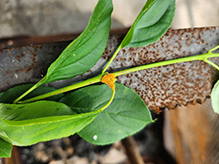 |
We found this on a volunteer Hawthorne tree choking out one of our decorative bushes. |
Greg Watson |
||
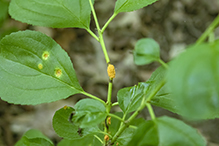 |
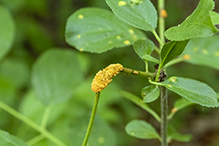 |
|
Orange-Yellow Rust I was hiking in Apple Blossom Overlook Park near La Crescent yesterday. I spotted the fungus on a Buckthorn. Don’t know the species of rust, probably Puccinia coronata var. avenae. A bit or research says that it also affects wheat and oat crops. Too bad, it would be great if it only hit Buckthorn. |
||
MinnesotaSeasons.com Photos |
||
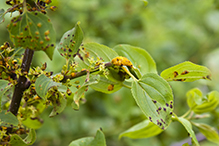 |
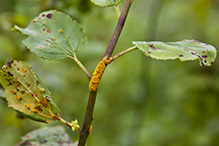 |
|
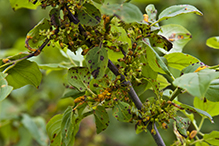 |
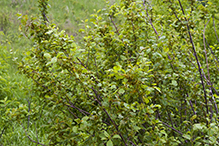 |

Slideshows |
Rez korunkatá - Puccinia coronata |
About
Published on Jul 17, 2012 No description available. |

Visitor Videos |
||
Share your video of this fungus. |
||
This button not working for you? |
||
|
Other Videos |
||
Oat leaf infected by Puccinia coronata |
About
Published on Aug 17, 2012 We're looking at the surface of an oat leaf. The orange spots are developing masses of spores of the fungus Puccinia coronata, which causes Crown Rust. These rust-colored spores (urediniospores) become wind-borne and can cause new infections on oat leaves, and also a wide range of other grasses including barley. Not shown: the secret life of P. coronata on its alternate host, common buckthorn. The video was taken over 5 days and 18 hours in our lab. This rust can make a bazillion microscopic spores in that time. |

Visitor Sightings |
||
Report a sighting of this fungus. |
||
This button not working for you? |
||
Karen Starr |
Location: Clinton Township, Michigan We found this on a volunteer Hawthorne tree choking out one of our decorative bushes. |
 |
| Carrie Frank 6/11/2023 |
Location: 2427 Dallman Lane SE Rochester Mn 55904 please provide advice. Thank you. |
|
| John Valo 6/11/2023 |
Crown Rust disfigures the leaves and stems on which it is found. However, it is not fatal to the plant. In some cities, Burnsville MN is one, the city encourages homeowners to pull up common buckthorn. Buckthorn is an undesirable, invasive, non-native plant that crowds out our native species. If your buckthorn has some crown rust on it, this may be a good time to get rid of it. |
|
MinnesotaSeasons.com Sightings |
||

Created: 6/12/2013 Last Updated: © MinnesotaSeasons.com. All rights reserved. |
